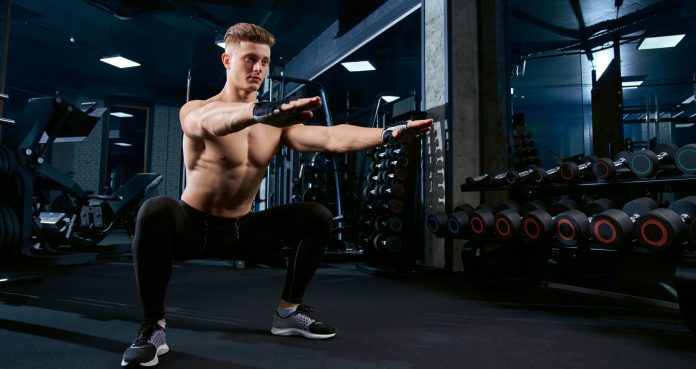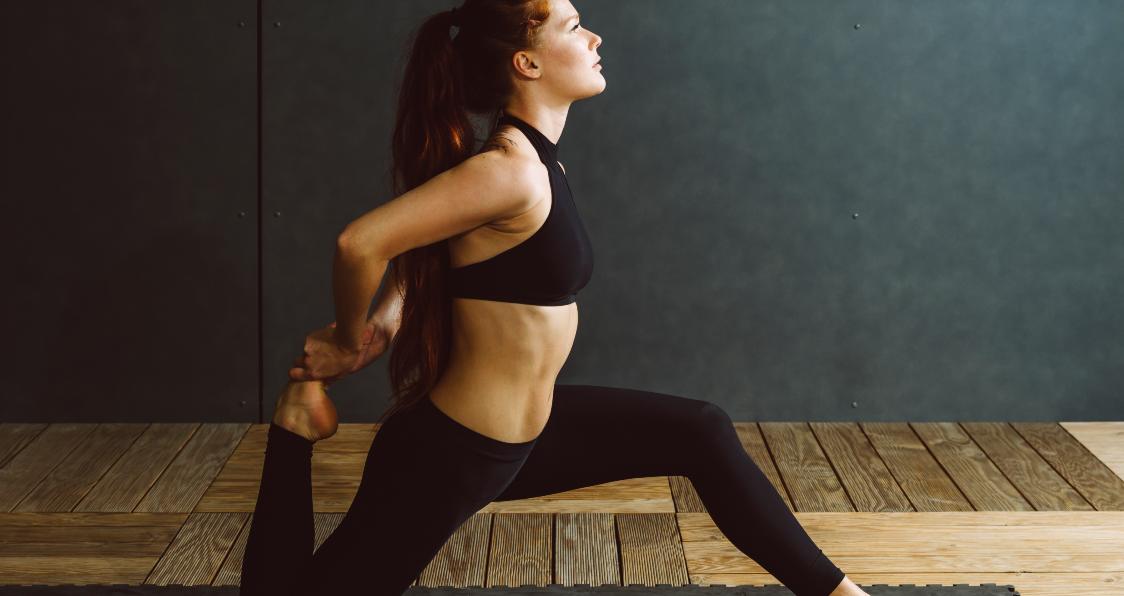
The Ultimate Beginner Leg Exercise for Strength and Movement
The goblet squat is one of the best beginner exercises in existence and makes an effective choice for those who wish to learn how to squat effectively.
Learning how to goblet squat will have a positive impact on how you perform when it comes to heavier squatting exercises such as the barbell back and front squats.
In addition, it may also be used to facilitate changes in lower extremity strength & mobility as well as serve as a useful tool for cardio-based interval workouts.
This article will provide information on how to safely and effectively perform the goblet squat, review the associated benefits and provide a number of goblet squat variations and alternatives.
Goblet Squat Technique & Muscles Worked
The goblet squats primarily works the muscles of the legs, in particular, the quads, glutes, and calves. In addition, core muscles are recruited in order to maintain stability.
If you are new to resistance training or have never performed the goblet squats before, it is highly recommended that you start with a light weight and gradually work up to a heavier load.
Use the following 3 steps to help you perform the perfect goblet squats.
1) The Set-Up
When performing the goblet squats, the first thing that should be determined is your setup. If you can get this right, the rest of the exercise should become relatively straightforward.
Start by assuming a stance that is slightly wider than hip-width. Pick up the weight and pin it in tightly to the chest while ensuring that the elbows stay tucked in to the ribcage.
The way in which you hold the weight is dependant on the type of weight you are using – if using a dumbbell, hold both sides of the handle; if using a dumbbell, hold it vertically.
2) Squatting Down
Before you begin to lower yourself into the squat, push the chest up and squeeze the core muscles.
As you gradually lower, keep the elbows tucked so that they do not get in the way of the knees. In addition, ensure that the feet stay flat on the floor at all times.
If you find that the heels are lifting from the floor at the bottom of the squat, you are either dropping too far or need to spend some time improving your ankle mobility as poor ankle mobility can lead to excessive trunk lean (1).
3) Driving Up
After dropping down deeply, drive hard through your heels to bring the body back up to the starting position.
It is very important that the core remains braced and the chest lifted during this phase in order to facilitate stability and control.

3 Goblet Squat Benefits
This section will highlight 3 of the biggest benefits that the beginner will experience by regularly practicing the goblet squats.
1) Improved Strength
The goblet squat may be a simple resistance exercise to perform, however, for the beginner, simple exercises are ideal as they are easy to master and still provide the body with ample stress to bring about significant adaptations in strength (2).
2) Improved Mobility
Because the weight is held to the front, it is possible to sit deeply into the squat. The weight serves as a counterbalance which facilitates a better trunk position and often allows for a deep squat.
3) Establishing Movement
As touched on, the goblet squat is the perfect exercise for any beginner who would like to progress onto heavy barbell squats. Practicing the goblet squats regularly will allow for neural pathways to be established thus improving squatting efficiency (3).

Common Goblet Squat Errors
There are 3 common errors that are associated with the goblet squats and should be avoided as far as possible.
These errors will not only cause the movement to become inefficient but may also increase the risk of sustaining an injury.
1) Falling Forwards
The reason for pushing the chest up during the goblet squat is to keep your center of balance over your base of support (feet).
Failure to keep the chest high often leads to the center of balance moving forward and away from your base of support causing you to lean forward excessively and fall.
2) Falling Backwards
While less common than a forward lean, some individuals may find themselves falling backward rather than forwards.
It is possible that the problem originates from a lack of tightness in your lats (back). To rectify this, look to pin your elbows in even tighter to the rib cage before squatting.
3) Wobbling
The most common reason for wobbling during a goblet squat is a lack of core tension. Failure to keep the core engaged will have a detrimental impact on overall stability.
Therefore, focus on squeezing the muscles in your trunk during each and every rep. This should keep you much more stable and allow you to move safely and more efficiently.

Goblet Squat Variations
If you are looking to increase the challenge of the goblet squats, consider any of the following variations.
Goblet Squat with Overhead Press
This variation will work the upper extremities as well as the lower – specifically working the shoulder, back and core muscles.
The exercise involves completing a standard goblet squats and then moving straight into an overhead press as you reach the top phase of the squat.
If you are running short of time, incorporating an overhead press at the top of the squat can be useful. It may also be an effective cardiovascular exercise and can easily be incorporated into a HIIT circuit.
For the press, it is possible to use both arms or to alternate arms with each rep.
The unilateral (one arm) version can be a useful tool for determining if one side is stronger than the other.
In addition, the unilateral press places a greater demand on the core as it must engage to keep the body upright and prevent any rotation from occurring.
Goblet Squat with Resistance Band
To increase the stress placed on the leg muscles, use a resistance band, placing it either around the tops of the ankles or knees.
Doing so will make the exercise very challenging as you must now resist the resistance band as it pulls your shins or knees inwards.
The goblet squats with resistance band is highly effective for strengthening the glute and quad muscles.
For the lifter who is struggling to keep the knees out during the squat, this method is highly recommended as the exercise forces the lifter to push the knees wide and activate key squatting muscles (4).

Double Kettlebell Front Squat
The double kettlebell front squat is probably the most challenging variation of the goblet squats as it doubles the load and requires precise technique.
Therefore, exercise caution and be absolutely sure that your technique is solid before progressing onto this variation. As when learning the goblet squat, start light and build up to heavier loads.
To perform this variation, start with the two kettlebells in the front rack position. This is where the elbows are lifted slightly to allow the load to comfortably rest on the arms.
When assuming this position, ensure that the handles of the kettlebells are held beside each other and are in close proximity to your chin. This should allow the weight to sit comfortably on the forearms.
Once in a solid front rack position, begin squatting ensuring that the elbows are kept up and the core is braced throughout.
Because of the position of the weight, this goblet squat variation is highly challenging on the core as it must work to keep the trunk upright and maintain stability.
Tempo, Pause and Pulse Squats
The most obvious way of making the goblet squats more challenging is to add more weight. however, if you only have access to one weight this can be a problem.
There are other ways that you can increase the intensity and challenge of the goblet squats without increasing the weight.
The first thing that you can manipulate is the tempo of the goblet squats. Start by slowing down the descent so that it takes 3-5 seconds to reach the bottom of the squat.
It may also be worthwhile to add a pause in at the bottom of the squat. For this method, descend as normal until you reach the bottom, hold this position for a couple of seconds before driving up.
You may even want to add in additional pauses at multiple stages as you drop and rise through the squat.
The final method that you may wish to consider is pulse squats. To perform pulse squats, firstly drop down deeply. From the bottom position, push up slightly and then drop down again.
Repeat this rising and dropping 5-10 times before driving all the way back up to standing. Keep the chest lifted throughout to ensure that you do not allow the back to round.
Final Word
For those who wish to progress on to heavy barbell squats, it is recommended to start with the goblet squats as it will allow you to learn the movement patterns for the squat and establish a base level of strength.
Let us know what you think in the comments below. Also, be sure to follow Generation Iron on Facebook, Twitter, and Instagram.
*Images courtesy of Envato
References:
1 – Fuglsang, Emil I.; Telling, Anders S.; Sørensen, Henrik (2017-11). “Effect of Ankle Mobility and Segment Ratios on Trunk Lean in the Barbell Back Squat”. Journal of Strength and Conditioning Research. 31 (11): 3024–3033. doi:10.1519/JSC.0000000000001872. ISSN 1533-4287. PMID 28301442.
2 – Baker, J. S.; Davies, B.; Cooper, S. M.; Wong, D. P.; Buchan, D. S.; Kilgore, L. (2013). “Strength and Body Composition Changes in Recreationally Strength-Trained Individuals: Comparison of One versus Three Sets Resistance-Training Programmes”. BioMed Research International. 2013. doi:10.1155/2013/615901. ISSN 2314-6133. PMC 3780552. PMID 24083231.
3 – Sale, D. G. (1988-10). “Neural adaptation to resistance training”. Medicine and Science in Sports and Exercise. 20 (5 Suppl): S135–145. doi:10.1249/00005768-198810001-00009. ISSN 0195-9131. PMID 3057313.
4 – Foley, Ryan C.A.; Bulbrook, Brittany D.; Button, Duane C.; Holmes, Michael W.R. (2017-8). “EFFECTS OF A BAND LOOP ON LOWER EXTREMITY MUSCLE ACTIVITY AND KINEMATICS DURING THE BARBELL SQUAT”. International Journal of Sports Physical Therapy. 12 (4): 550–559. ISSN 2159-2896. PMC 5534145. PMID 28900561.
